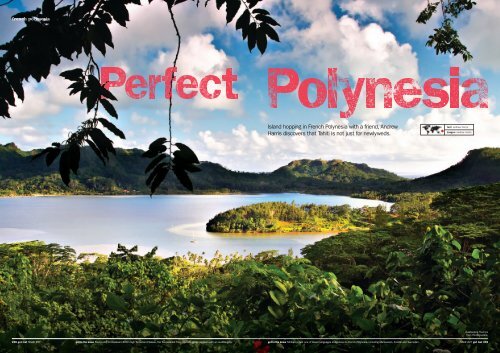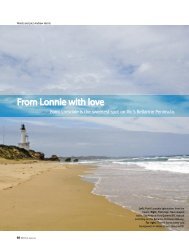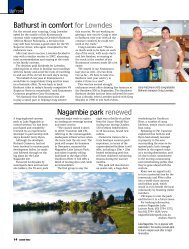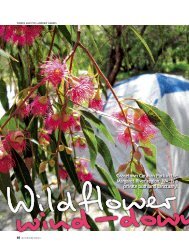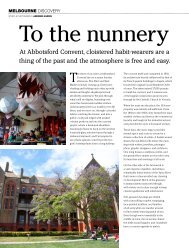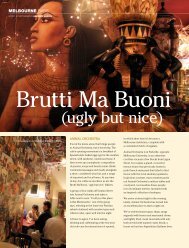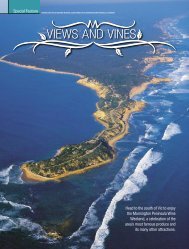Island hopping in French Polynesia with a friend, Andrew Harris ...
Island hopping in French Polynesia with a friend, Andrew Harris ...
Island hopping in French Polynesia with a friend, Andrew Harris ...
- No tags were found...
You also want an ePaper? Increase the reach of your titles
YUMPU automatically turns print PDFs into web optimized ePapers that Google loves.
french polynesiaHear<strong>in</strong>g of our travel plans, a couple of <strong>friend</strong>sjoked that me and my buddy Dave should fly to Tahiti on apackage honeymoon. But as anyone who’s been to <strong>French</strong><strong>Polynesia</strong> will know, there’s far more to it to than canoodl<strong>in</strong>gcouples sipp<strong>in</strong>g cocktails under nodd<strong>in</strong>g palms, and tak<strong>in</strong>goccasional breathers to shop for black pearl earr<strong>in</strong>gs.And besides, my ears aren’t pierced.Tahiti is an anachronism wrapped <strong>in</strong> a culture clash, enveloped<strong>in</strong> a <strong>Polynesia</strong>n Eden, tens of thousands of kilometres from its<strong>in</strong>fatuated coloniser. It’s said that <strong>French</strong> <strong>Polynesia</strong>, a nom<strong>in</strong>allyautonomous overseas dependency of France, costs the <strong>French</strong>Government a billion euros a year. It has no natural resources,little obvious strategic advantage, and a grow<strong>in</strong>g <strong>in</strong>dependencemovement, but the <strong>French</strong> just can’t let it go – it’s just too ach<strong>in</strong>glybeautiful. Meanwhile, the locals couldn’t really live <strong>with</strong>out the<strong>French</strong>: zero <strong>in</strong>come tax for anyone who’s not self-employed;outstand<strong>in</strong>g healthcare, education and <strong>in</strong>frastructure; andgovernment-mandated m<strong>in</strong>imum prices for crops such as copra thatare well above the regional average. All of this manifests <strong>in</strong> ethnicTahitians gadd<strong>in</strong>g about <strong>with</strong> baguettes; the ready availability ofwaterfalls, ribbon<strong>in</strong>g down the mounta<strong>in</strong>ous sp<strong>in</strong>e of the m<strong>in</strong>iisland,disappear<strong>in</strong>g <strong>in</strong>to the density of treetops beh<strong>in</strong>d roadsidevillages. We pull over. And stare. Imag<strong>in</strong>e a thunder<strong>in</strong>g waterfall<strong>in</strong> your backyard.Around 300,000 lucky people call the 130 or so islandsof <strong>French</strong> <strong>Polynesia</strong> home. Well over half live on the islandof Tahiti, the overwhelm<strong>in</strong>g majority of whom (about 120,000)live <strong>in</strong> and around the sprawl of the capital, Papeete.The populace is ethnically stratified <strong>in</strong>to resident <strong>French</strong>,native Tahitians, a significant and long-term diasporic Ch<strong>in</strong>esepopulation, and the demi, as they call themselves, who are mixedrace.That said, everyone is such a melange <strong>with</strong> mixed heritagethat <strong>in</strong> many cases these dist<strong>in</strong>ctions don’t apply. And as a resultof all the <strong>in</strong>term<strong>in</strong>gl<strong>in</strong>g, racism seems virtually non-existent.Barely a take off and land<strong>in</strong>g away from Tahiti, Raiatea is anisland <strong>with</strong> very different energy – it’s said this is the spiritualground zero for <strong>Polynesia</strong>ns, where all souls must pass throughto get to heaven. And from where all souls come <strong>in</strong> the firstplace. Some of the rarest plants <strong>in</strong> the world grow here. There’ssometh<strong>in</strong>g special, odd, <strong>in</strong> the air. Maybe that’s why the eels“The next day we f<strong>in</strong>d ourselves on an isolated promontory of Huah<strong>in</strong>e <strong>in</strong> the villageof Haapu. Here, we f<strong>in</strong>d a clutch of petanque players, and after a few passes on thescooters, we climb del<strong>in</strong>quent-like through a hole <strong>in</strong> a cha<strong>in</strong>-l<strong>in</strong>k fence to jo<strong>in</strong> them.heart-stopp<strong>in</strong>g <strong>French</strong> pastries; and hulk<strong>in</strong>g, tattooed youngmen play<strong>in</strong>g Sunday afternoon petanque – European lawn bowls.In the balmy light of our first morn<strong>in</strong>g on Tahiti, from thebalcony of our room we’re greeted by Bora Bora, hazy <strong>in</strong> thedistance. We walk outside to a compressed staircase of foldedgreen mounta<strong>in</strong>s, ris<strong>in</strong>g high <strong>in</strong>to Tahiti’s deep <strong>in</strong>terior, wherethere’s a two-day hike to the summit of the highest peak.We’re <strong>in</strong> <strong>French</strong> <strong>Polynesia</strong> for ten days, island <strong>hopp<strong>in</strong>g</strong> aroundthe Society <strong>Island</strong>s group, of which Tahiti is pr<strong>in</strong>cipal, to seewhat makes the region tick. The first th<strong>in</strong>g I want to do is acircumnavigation by road (117 kilometres <strong>in</strong> this case). What iscommonly known as ‘Tahiti’ is actually two islands – Tahiti Nui(Big Tahiti) and Tahiti Iti (Little Tahiti) – jo<strong>in</strong>ed like a lopsidedbarbell by a narrow strip. Despite the presence of that four-lanehighway on Nui (of which many of the locals are immenselyproud), at the other end of the two-island complex there’s no roadat all. If you want to keep go<strong>in</strong>g it’s a precarious predicament ofpick<strong>in</strong>g your way over rocks, and defend<strong>in</strong>g yourself aga<strong>in</strong>st straydogs as mad as hellspawn. It’s like driv<strong>in</strong>g from the backblocksof Paris to the edge of the earth <strong>in</strong> about half an hour.Some way along Iti, we’re struck by a str<strong>in</strong>g of high-strungPaddl<strong>in</strong>g the warmwaters <strong>in</strong>side thereef of Huah<strong>in</strong>e.”are so big. We’re snorkell<strong>in</strong>g off the side of a private speedboat,maybe a kilometre or so offshore when I take a deep drag of airand dive to the sandy bottom. I’m met <strong>with</strong> schools of brightlycoloured fish, the occasional coral crop, and a ray <strong>in</strong> the distance.Just near a drop-off, a monstrously long moray eel nips <strong>in</strong> andout of its hide. Almost <strong>in</strong> greet<strong>in</strong>g; almost <strong>in</strong> reproach. And then Isee another. Even bigger. Probably two metres long, if it felt likereveal<strong>in</strong>g its entire self.I could be imag<strong>in</strong><strong>in</strong>g th<strong>in</strong>gs, but when I surface and remove mymask, I can smell vanilla. It’s waft<strong>in</strong>g from the plantations on thenearby island of Taha’a, only a few kilometres away, and <strong>in</strong> pla<strong>in</strong>view. Later on, when we do get to Taha’a, you really can smellvanilla <strong>in</strong> the air, well before we reach the plantation, where I buy abundle of 20 pods for about A$30. They’re the f<strong>in</strong>est <strong>in</strong> the world,<strong>with</strong> a perfect moisture content; sun-dried by hand, shifted andturned to face the rays, for at least a year. You’d struggle to f<strong>in</strong>dthem <strong>in</strong> Australia, and if you did, they’d cost almost that much each.The other great cul<strong>in</strong>ary highlight of <strong>French</strong> <strong>Polynesia</strong> is thelocal tuna. Kilo upon kilo of the freshest, most supple fish I’veever experienced. In an all-night supermarket, alongside a rangeof baked sweets, we f<strong>in</strong>d fresh tuna <strong>in</strong> all its glory – great big<strong>in</strong>ky hunks of it: sushi, sashimi and all the rest. Beats Doritosfor a snack. At every lunch stop along the way, poisson cru (thelocal raw tuna salad) is the star dish, alongside melt-<strong>in</strong>-the mouthcarpaccio de thon – paper-th<strong>in</strong> slices of fish drizzled <strong>with</strong> vanilla<strong>in</strong>fusedolive oil. And if you like your tuna cooked, you’ll f<strong>in</strong>d itsmothered <strong>in</strong> rich vanilla sauce. Given half a chance, I wouldhave sat around eat<strong>in</strong>g various forms of tuna for the entire trip.Local specialities aside, France ensures that all the denizensof its national mistress are fed and watered <strong>with</strong> the f<strong>in</strong>est theworld can offer. Here, New Zealand beef is streaks better than thebest of what the Kiwis eat. Every <strong>French</strong> cheese known to manis available <strong>in</strong> the hangar-sized Carrefour supermarket near theairport <strong>in</strong> Faaa, Tahiti – a nice bottle of Bordeaux <strong>with</strong> the even<strong>in</strong>gmeal seems a constitutional right.A 20-m<strong>in</strong>ute hop from Raiatea is the marvellous tangle ofmounta<strong>in</strong>s, <strong>in</strong>lets and lagoon known <strong>in</strong> Tahitian as Huah<strong>in</strong>e.For better or worse, this translates most directly as ‘vag<strong>in</strong>a’.#40 get lost ISSUE #27 get <strong>in</strong> the know Tahiti’s highest po<strong>in</strong>t is Mount Orohena at 2241m, located roughly <strong>in</strong> the centre of the island.get <strong>in</strong> the know When referr<strong>in</strong>g to the scenery, rupe (roo-peh) is ‘beautiful’ <strong>in</strong> Tahitian, but to describe a woman ‘beautiful’ is nehe nehe (ne-hi ne-hi).All the colours of thefishy ra<strong>in</strong>bow, freshlycaught <strong>in</strong> Huah<strong>in</strong>e.ISSUE #27 get lost #41
french polynesiaI’m not entirely sure what that’s about. Alocal tells us it’s likely ‘Huah<strong>in</strong>e’ meanssometh<strong>in</strong>g closer to ‘woman’, <strong>in</strong> whichcase it’s probably got someth<strong>in</strong>g to do <strong>with</strong>all the many curvy curves of the island,and its extraord<strong>in</strong>ary aesthetic attributes.As soon as we arrive on Huah<strong>in</strong>e, wehire some underpowered Yamahas. It’s60 kilometres around the island, which isstructured like Tahiti, <strong>with</strong> a Huah<strong>in</strong>e Nuiand a Huah<strong>in</strong>e Iti l<strong>in</strong>ked by an isthmus,and our steeds manage much of it. Withthe notable exception of an outlandishlysteep section on the west side of theisland up the belvedere or ‘lookout’.Putt<strong>in</strong>g along like a golf cart conta<strong>in</strong><strong>in</strong>ga sumo wrestler, our Yammies deliver usto the lookout, and its cloud of ravenousmosquitoes, through which we take <strong>in</strong> anexpansive confluence of blues and greens;<strong>in</strong>lets, lagoons and forested hills. By thetime we return to our digs, the colourpalette has changed to yellow, orangeand ochre. The sun drops below Taha’a,sett<strong>in</strong>g it ablaze.The next day we f<strong>in</strong>d ourselves on anisolated promontory of Huah<strong>in</strong>e <strong>in</strong> thevillage of Haapu. Here, we f<strong>in</strong>d a clutch ofpetanque players, and after a few passeson the scooters, we climb del<strong>in</strong>quent-likethrough a hole <strong>in</strong> a cha<strong>in</strong>-l<strong>in</strong>k fence tojo<strong>in</strong> them. A backdrop of bright water andmounta<strong>in</strong>s, the handful of s<strong>in</strong>gleted menand their almost da<strong>in</strong>ty, chrome balls playout their game as if <strong>in</strong> prov<strong>in</strong>cial France.We engage <strong>in</strong> some banter about theweather “Chaud [hot],” I remark, sweat<strong>in</strong>gprofusely to emphasise the po<strong>in</strong>t. “Oui,”one of them <strong>in</strong>dulges me, sweat<strong>in</strong>g onlya little “Très chaud [very hot].” It’s onlywhen we scoot off, and round the rest ofthe island, that we realise this is one suchscene of many; petanque, swimm<strong>in</strong>g kids,family gather<strong>in</strong>gs, the whole way around.At the beg<strong>in</strong>n<strong>in</strong>g of a slow dusk, nearthe island’s ma<strong>in</strong> village of Fare, we’reout on another promontory, watch<strong>in</strong>g anadolescent fi sherman haul <strong>in</strong> his catch.His mum and dad wait for him, laz<strong>in</strong>gunder a small shelter. There’s a beatenupCorolla hatch; a boombox <strong>in</strong> the backplay<strong>in</strong>g someth<strong>in</strong>g 90s. Then fi sherboyturns around, <strong>with</strong> the most <strong>in</strong>credibleriot of ra<strong>in</strong>bow-splashed fi sh I’ve everseen. It’s like a scaly disco ball, dangl<strong>in</strong>gat the end of his l<strong>in</strong>e. He chucks thefi sh <strong>in</strong> the boot. They slap aga<strong>in</strong>st theboombox. We hop on our scooters, wavegoodbye, and ride <strong>in</strong>to the sunset.On our last afternoon on Huah<strong>in</strong>e,we’re paddl<strong>in</strong>g out near where the reefdrops off <strong>in</strong>to the ocean. We’ve had ago at the heavy wooden outrigger canoethat is the national sport here, the va’a,but we ended up go<strong>in</strong>g round <strong>in</strong> circles,and traded it for two plastic kayaks.The lagoon is so perspex blue it’s likean artist’s impression of how a lagoonshould be. A ray smudges grey along thebottom. The sun is low; the water bloodwarm, and the sprawl<strong>in</strong>g amorphousshape of Huah<strong>in</strong>e appears as noth<strong>in</strong>gmore than a green lump on the horizon.We contemplate paddl<strong>in</strong>g around thecoast to the stunn<strong>in</strong>g, fjord-like <strong>in</strong>letwhere we’d seen the fi shy discoball.Stroke by stroke, the lagoon turns purple,blends <strong>in</strong>to the sky, and I can alreadytaste tonight’s vanilla-sauced tuna.BORA BORASouth PacificMAUPITI TAHAAHUAHINEHAVA’ISouth PacificFRENCH POLYNESIAPapeeteMAÏAOMOOREATAHITIget plann<strong>in</strong>gget thereEmirates and Air New Zealand fly fromAustralia to Auckland, from A$450 return.Then connect to an Air Tahiti Nui flightto Papeete for about A$570 return.www.emirates.comwww.airnewzealand.com.auwww.airtahit<strong>in</strong>ui.comstay thereVeteran surfer Ralph’s brilliant TaaroaLodge is the most chilled out place tostay on Tahiti. There’s a couple ofbungalows all <strong>with</strong> beach views acrossto Bora Bora. www.taaroalodge.comFor a night of tasteful, secluded luxury,don’t miss Te Tiare Beach Resort.www.tetiarebeachresort.comContemplat<strong>in</strong>g life <strong>in</strong> anearthly Eden, on Huah<strong>in</strong>e.V<strong>in</strong>i Beach Lodge is located <strong>in</strong> probably thebest spot on Raiatea, <strong>with</strong> five good-value,spacious self-conta<strong>in</strong>ed bungalows arounda pool on the edge of mounta<strong>in</strong>-rimmedFaaroa Bay. www.raiatea.com/v<strong>in</strong>ibeachMore <strong>in</strong>formationMay to October temperatures stay aroundthe high 20s and there’s virtually no ra<strong>in</strong>.It’s a bit pricier, but if you have limitedtime, you won’t have to worry about tropicaldownpours ru<strong>in</strong><strong>in</strong>g your fun.#42 get lost ISSUE #27get <strong>in</strong> the know Raitea, Huah<strong>in</strong>e, Taha’a and Tahiti, all form part of an archipelago known as the Society <strong>Island</strong>s.


